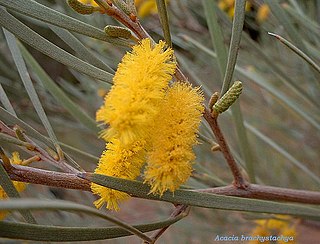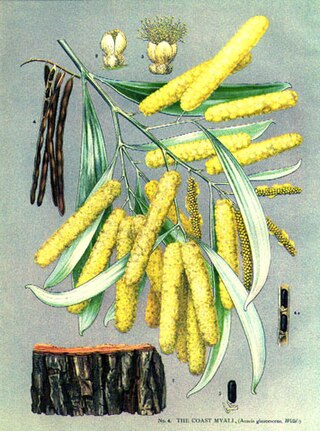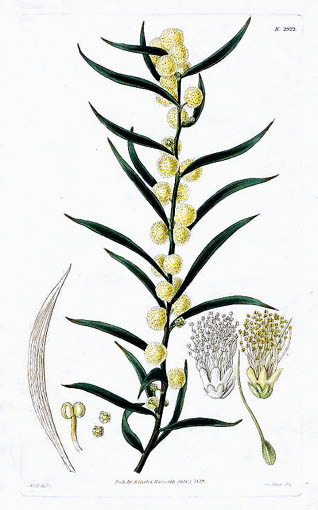
Acacia pycnantha, most commonly known as the golden wattle, is a tree of the family Fabaceae. It grows to a height of 8 metres and has phyllodes instead of true leaves. The profuse fragrant, golden flowers appear in late winter and spring, followed by long seed pods. Explorer Thomas Mitchell collected the type specimen, from which George Bentham wrote the species description in 1842. The species is native to southeastern Australia as an understorey plant in eucalyptus forest. Plants are cross-pollinated by several species of honeyeater and thornbill, which visit nectaries on the phyllodes and brush against flowers, transferring pollen between them.

Acacia brachystachya, commonly known as umbrella mulga, turpentine mulga or false bowgada, is a shrub in the family Fabaceae. The species occurs in mulga and heath communities on sandhills and rocky ridges in all mainland states of Australia, except Victoria.

Acacia decurrens, commonly known as black wattle or early green wattle, is a perennial tree or shrub native to eastern New South Wales, including Sydney, the Greater Blue Mountains Area, the Hunter Region, and southwest to the Australian Capital Territory. It grows to a height of 2–15 m (7–50 ft) and it flowers from July to September.

Acacia binervia, commonly known as the coast myall, is a wattle native to New South Wales and Victoria. It can grow as a shrub or as a tree reaching 16 m in height. This plant is reportedly toxic to livestock as the foliage (phyllodes) contain a glucoside which can produce hydrogen cyanide if cut.

Acacia triptera, commonly known as spurwing wattle, is an erect or spreading shrub which is endemic to Australia.

Acacia oxycedrus, commonly known as spike wattle, is an erect or spreading shrub which is endemic to Australia.

Acacia suaveolens is a shrub species endemic to Australia. It grows to between 0.3 and 3.5 metres high and has smooth purplish-brown or light green bark and has straight or slightly curving blue-green phyllodes The pale yellow to near white globular flower heads generally appear between April and September in its native range. These are followed by flattened, bluish oblong pods which are up to 2 to 5 cm long and 8 to 19 mm wide.

Acacia howittii, commonly known as sticky wattle or Howitt's wattle, is a tree species that is endemic to Victoria, Australia.

Acacia lanigera, commonly known as woolly wattle or hairy wattle, is a tree species that is endemic south eastern Australia.

Acacia buxifolia, commonly known as box-leaf wattle, is shrub species that is endemic to eastern Australia.

Acacia mitchellii, commonly known as Mitchell's wattle, is an erect or spreading shrub which is endemic to Australia. It grows to up to 2 metres high and has small bipinnate leaves. The pale yellow globular flowerheads appear in groups of 1 to 3 in the axils of the phyllodes followed by straight or curved seed pods which are 1.8 to 5 cm long and 4 to 8 mm wide.

Acacia aspera, commonly known as rough wattle, is a spreading shrub which is endemic to south-eastern Australia. It grows to up to 2 metres high and has phyllodes which are 10 to 30 mm long and 2 –4 mm wide. The pale yellow to gold globular flowerheads appear singly or in groups of two in the axils of the phyllodes in July to September, followed by curved or coiled seed pods which are 20 to 70 mm long and 3 to 5 mm wide.

Acacia gunnii, commonly known as ploughshare wattle or dog's tooth wattle, is a woody shrub which is endemic to south-eastern Australia found in dry heaths and woodlands. It ranges from Queensland, then New South Wales, Australian Capital Territory, Victoria, South Australia, down to Tasmania. Acacia gunnii grows to up to 1 metre high and has prickly phyllodes which are 4 to 15 mm long. The cream to pale yellow globular flowerheads appear singly in the axils of the phyllodes in June to October, followed by curved or coiled seed pods which are 40 mm long and 4 to 5 mm wide. Acacia gunnii grows up to 1 meter tall and has prickly phyllodes which are 4 to 15mm in length with cream to pale-yellow globular flower heads appearing in phyllode axils in June through to October, followed by curved or coiled seed pods which are 40mm long and 4 to 5 mm wide. The species was first formally described by English botanist George Bentham in the London Journal of Botany in 1842. It occurs in South Australia, Victoria, Tasmania, New South Wales, Australian Capital Territory, and Queensland.

Acacia rigens, commonly known as nealie, is an erect or spreading shrub or small tree that is endemic to Australia. Other common names include needle wattle, needlebush acacia, nealia and nilyah.

Acacia prominens is a shrub or tree in the genus Acacia native to New South Wales, Australia.

Acacia lineataA.Cunn. ex G.Don, commonly known as streaked wattle or narrow lined-leaved wattle, occurs naturally inland eastern Australia. The genus Acacia is the largest genus of flowering plants in Australia, containing around 1000 species throughout a diverse range of environments from coast to desert.

Acacia loderi, known colloquially as nelia or nealie, is a species of Acacia native to Australia.

Acacia phasmoides, the phantom wattle, is a shrub species that is endemic to south-eastern Australia.

Acacia difformis is a shrub or small tree in the Fabaceae family that is native to New South Wales and Victoria and grows to a height of 2 to 7 m. Common names include Drooping wattle, Wyalong wattle or Mystery wattle. Acacia difformis grows in sandy soils, open forests, and usually occurs in mallee communities. the name difformis comes from post-classical Latin which means irregularly or unevenly or differently formed.

Acacia subporosa, also commonly known as river wattle, bower wattle, narrow-leaf bower wattle and sticky bower wattle, is a tree or shrub of the genus Acacia and the subgenus Plurinerves that is endemic to an area of south eastern Australia. It is considered to be rare in Victoria





















